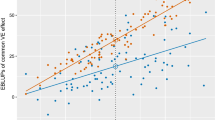Summary
The gains in yields of mixtures expected to follow various methods of selection of components from populations of randomly constituted mixtures are formulated in terms of a statistical model and a model of first-order inter-plant competition. The types of selection investigated include that among whole mixtures and among groups or individual components on a within-mixture or unrestricted basis, or on the basis of the yields of sets of mixtures to which the group or individual is common. In all cases the sizes of mixture used for selection and for measurement of gain may differ. While evaluation of components in groups or whole mixtures allows selection for component interactions, gains are lower overall because of the reduction in variance caused by grouping. Gains due to interaction are lost if the components are pooled after selection, as in a population improvement programme. Individual selection carries some risk of negative gains, but these are reduced if assessment is made on an unrestricted rather than within-mixture basis. When second and higher order competitive interactions are absent, monoculture assessment is expected to be an efficient means of selection of components for binary and tertiary mixtures.
Similar content being viewed by others
References
Falconer DA (1960) Introduction to quantitative genetics. Oliver and Boyd, London
Griffing B (1967) Selection in reference to biological groups. 1. Individual and group selection applied to populations of unordered groups. Aust J Biol Sci 20:127–139
Griffing B (1968) Selection in reference to biological groups. 2. Consequences of selection in groups of one size when evaluated in groups of a different size. Aust J Biol Sci 21:163–170
Griffing B (1969) Selection in reference to biological groups. 4. Application of selection index theory. Aust J Biol Sci 22:131–142
Hamblin J, Donald CM (1974) The relationships between plant form, competitive ability and grain yield in a barley cross. Euphytica 23:519–526
Wright AJ (1982) Some implications of a first-order model of interplant competition for the means and variances of complex mixtures. Theor Appl Genet 64:91–96
Author information
Authors and Affiliations
Additional information
Communicated by A. Robertson
Rights and permissions
About this article
Cite this article
Wright, A.J. The expected efficiencies of some methods of selection of components for inter-genotypic mixtures. Theoret. Appl. Genetics 67, 45–52 (1983). https://doi.org/10.1007/BF00303921
Received:
Accepted:
Issue Date:
DOI: https://doi.org/10.1007/BF00303921




